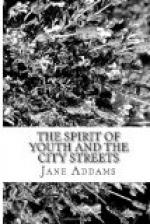Possibly these fifteen thousand youths were brought to grief because the adult population assumed that the young would be able to grasp only that which is presented in the form of sensation; as if they believed that youth could thus early become absorbed in a hand to mouth existence, and so entangled in materialism that there would be no reaction against it. It is as though we were deaf to the appeal of these young creatures, claiming their share of the joy of life, flinging out into the dingy city their desires and aspirations after unknown realities, their unutterable longings for companionship and pleasure. Their very demand for excitement is a protest against the dullness of life, to which we ourselves instinctively respond.
CHAPTER IV
THE HOUSE OF DREAMS
To the preoccupied adult who is prone to use the city street as a mere passageway from one hurried duty to another, nothing is more touching than his encounter with a group of children and young people who are emerging from a theater with the magic of the play still thick upon them. They look up and down the familiar street scarcely recognizing it and quite unable to determine the direction of home. From a tangle of “make believe” they gravely scrutinize the real world which they are so reluctant to reenter, reminding one of the absorbed gaze of a child who is groping his way back from fairy-land whither the story has completely transported him.
“Going to the show” for thousands of young people in every industrial city is the only possible road to the realms of mystery and romance; the theater is the only place where they can satisfy that craving for a conception of life higher than that which the actual world offers them. In a very real sense the drama and the drama alone performs for them the office of art as is clearly revealed in their blundering demand stated in many forms for “a play unlike life.” The theater becomes to them a “veritable house of dreams” infinitely more real than the noisy streets and the crowded factories.
This first simple demand upon the theater for romance is closely allied to one more complex which might be described as a search for solace and distraction in those moments of first awakening from the glamour of a youth’s interpretation of life to the sterner realities which are thrust upon his consciousness. These perceptions which inevitably “close around” and imprison the spirit of youth are perhaps never so grim as in the case of the wage-earning child. We can all recall our own moments of revolt against life’s actualities, our reluctance to admit that all life was to be as unheroic and uneventful as that which we saw about us, it was too unbearable that “this was all there was” and we tried every possible avenue of escape. As we made an effort to believe, in spite of what we saw, that life was noble and harmonious, as we stubbornly clung to




